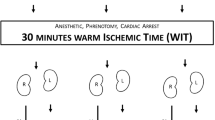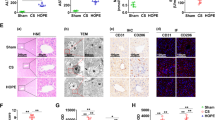Abstract
Ischemia/reperfusion (I/R) injury is an unavoidable barrier that significantly affects outcome of solid organ transplantation. Here, we establish a protein transduction system to extend graft preservation time and to prevent I/R injury in heart transplantation. We generated a recombinant heme oxygenase-1 (HO-1) protein containing a modified protein transduction domain (PTD). PTD could cross cover cell membrane and carry target molecule to parenchymal cells of cold-preserved heart grafts. The newly generated PTD-HO-1 protein localized mainly in subcellular membrane organelle and nucleus after delivery that significantly prolonged cold preservation of heart grafts. This effect was associated with significantly less endothelial cell activation, less neutrophil and macrophage infiltration in PTD-HO-1-transduced heart grafts after reperfusion as compared with controls. In addition, transduction of PTD-HO-1 protein to heart graft significantly suppressed the I/R injury-associated myocardiocyte apoptosis. The infarct areas of heart graft after I/R injury were significantly reduced after PTD-HO-1 protein treatment. We show here for the first time that PTD can maintain its biological activities during cold preservation. Transduction of cell penetrating HO-1 protein significantly prolongs the cold preservation time and protects the graft from the I/R injury. This approach represents a novel method for the improvement of the overall outcome of organ transplantation.
This is a preview of subscription content, access via your institution
Access options
Subscribe to this journal
Receive 12 print issues and online access
$259.00 per year
only $21.58 per issue
Buy this article
- Purchase on Springer Link
- Instant access to full article PDF
Prices may be subject to local taxes which are calculated during checkout





Similar content being viewed by others
Abbreviations
- CK-MB:
-
creatine kinase-MB
- CoPPIX:
-
cobalt protoporphyrin IX
- HO:
-
heme oxygenase
- I/R:
-
ischemia and reperfusion
- PTD:
-
protein transduction domain
- TTC:
-
triphenyltertrazolium chloride
References
Lefer AM, Tsao PS, Lefer DJ, Ma XL . Role of endothelial dysfunction in the pathogenesis of reperfusion injury after myocardial ischemia. FASEB J 1991; 5: 2029–2034.
Tilney NL, Guttmann RD . Effects of initial ischemia/reperfusion injury on the transplanted kidney. Transplantation 1997; 64: 945–947.
Jaeschke H, Farhood A, Smith CW . Neutrophils contribute to ischemia/reperfusion injury in rat liver in vivo. FASEB J 1990; 4: 3355–3359.
Jordan JE, Zhao ZQ, Vinten-Johansen J . The role of neutrophils in myocardial ischemia-reperfusion injury. Cardiovasc Res 1999; 43: 860–878.
Takada M, Nadeau KC, Shaw GD, Marquette KA, Tilney NL . The cytokine-adhesion molecule cascade in ischemia/reperfusion injury of the rat kidney. Inhibition by a soluble P-selectin ligand. J Clin Invest 1997; 99: 2682–2690.
Scarabelli TM, Stephanou A, Pasini E, Comini L, Raddino R, Knight RA et al. Different signaling pathways induce apoptosis in endothelial cells and cardiac myocytes during ischemia/reperfusion injury. Circ Res 2002; 90: 745–748.
Gottlieb RA, Burleson KO, Kloner RA, Babior BM, Engler RL . Reperfusion injury induces apoptosis in rabbit cardiomyocytes. J Clin Invest 1994; 94: 1621–1628.
Maines MD . The heme oxygenase system: a regulator of second messenger gases. Annu Rev Pharmacol Toxicol 1997; 37: 517–554.
Sun J, Loehr TM, Wilks A, Ortiz de Montellano PR . Identification of histidine 25 as the heme ligand in human liver heme oxygenase. Biochemistry 1994; 33: 13734–13740.
Wilks A, Ortiz de Montellano PR, Sun J, Loehr TM . Heme oxygenase (HO-1): His-132 stabilizes a distal water ligand and assists catalysis. Biochemistry 1996; 35: 930–936.
Otterbein LE, Bach FH, Alam J, Soares M, Tao Lu H, Wysk M et al. Carbon monoxide has anti-inflammatory effects involving the mitogen-activated protein kinase pathway. Nat Med 2000; 6: 422–428.
Yachie A, Niida Y, Wada T, Igarashi N, Kaneda H, Toma T et al. Oxidative stress causes enhanced endothelial cell injury in human heme oxygenase-1 deficiency. J Clin Invest 1999; 103: 129–135.
Vile GF, Basu-Modak S, Waltner C, Tyrrell RM . Heme oxygenase 1 mediates an adaptive response to oxidative stress in human skin fibroblasts. Proc Natl Acad Sci USA 1994; 91: 2607–2610.
Soares MP, Lin Y, Anrather J, Csizmadia E, Takigami K, Sato K et al. Expression of heme oxygenase-1 can determine cardiac xenograft survival. Nat Med 1998; 4: 1073–1077.
Tsui TY, Siu YT, Schlitt HJ, Fan ST . Heme oxygenase-1-derived carbon monoxide stimulates adenosine triphosphate generation in human hepatocyte. Biochem Biophys Res Commun 2005; 336: 898–902.
Katori M, Buelow R, Ke B, Ma J, Coito AJ, Iyer S et al. Heme oxygenase-1 overexpression protects rat hearts from cold ischemia/reperfusion injury via an antiapoptotic pathway. Transplantation 2002; 73: 287–292.
Amersi F, Buelow R, Kato H, Ke B, Coito AJ, Shen XD et al. Upregulation of heme oxygenase-1 protects genetically fat Zucker rat livers from ischemia/reperfusion injury. J Clin Invest 1999; 104: 1631–1639.
Yet SF, Tian R, Layne MD, Wang ZY, Maemura K, Solovyeva M et al. Cardiac-specific expression of heme oxygenase-1 protects against ischemia and reperfusion injury in transgenic mice. Circ Res 2001; 89: 168–173.
DeBruyne LA, Magee JC, Buelow R, Bromberg JS . Gene transfer of immunomodulatory peptides correlates with heme oxygenase-1 induction and enhanced allograft survival. Transplantation 2000; 69: 120–128.
Tsui TY, Wu X, Lau CK, Ho DW, Xu T, Siu YT et al. Prevention of chronic deterioration of heart allograft by recombinant adeno-associated virus-mediated heme oxygenase-1 gene transfer. Circulation 2003; 107: 2623–2629.
Ford KG, Souberbielle BE, Darling D, Farzaneh F . Protein transduction: an alternative to genetic intervention? Gene Therapy 2001; 8: 1–4.
Schwarze SR, Ho A, Vocero-Akbani A, Dowdy SF . In vivo protein transduction: delivery of a biologically active protein into the mouse. Science 1999; 285: 1569–1572.
Vocero-Akbani AM, Heyden NV, Lissy NA, Ratner L, Dowdy SF . Killing HIV-infected cells by transduction with an HIV protease-activated caspase-3 protein. Nat Med 1999; 5: 29–33.
Nagahara H, Vocero-Akbani AM, Snyder EL, Ho A, Latham DG, Lissy NA et al. Transduction of full-length TAT fusion proteins into mammalian cells: TAT-p27Kip1 induces cell migration. Nat Med 1998; 4: 1449–1452.
Vives E, Brodin P, Lebleu B . A truncated HIV-1 tat protein basic domain rapidly translocates through the plasma membrane and accumulates in the cell nucleus. J Biol Chem 1997; 272: 16010–16017.
Ho A, Schwarze SR, Mermelstein SJ, Waksman G, Dowdy SF . Synthetic protein transduction domains: enhanced transduction potential in vitro and in vivo. Cancer Res 2001; 61: 474–477.
Azuma H, Nadeau K, Takada M, Mackenzie HS, Tilney NL . Cellular and molecular predictors of chronic renal dysfunction after initial ischemia/reperfusion injury of a single kidney. Transplantation 1997; 64: 190–197.
Blydt-Hansen TD, Katori M, Lassman C, Ke B, Coito AJ, Iyer S et al. Gene transfer-induced local heme oxygenase-1 overexpression protects rat kidney transplants from ischemia/reperfusion injury. J Am Soc Nephrol 2003; 14: 745–754.
Pachori AS, Melo LG, Hart ML, Noiseux N, Zhang L, Morello F et al. Hypoxia-regulated therapeutic gene as a preemptive treatment strategy against ischemia/reperfusion tissue injury. Proc Natl Acad Sci USA 2004; 101: 12282–12287.
Tullius SG, Nieminen-Kelha M, Buelow R, Reutzel-Selke A, Martins PN, Pratschke J et al. Inhibition of ischemia/reperfusion injury and chronic graft deterioration by a single-donor treatment with cobalt-protoporphyrin for the induction of heme oxygenase-1. Transplantation 2002; 74: 591–598.
Vreman HJ, Cipkala DA, Stevenson DK . Characterization of porphyrin heme oxygenase inhibitors. Can J physiol pharmacol 1996; 74: 278–285.
Cavazzana-Calvo M, Thrasher A, Mavilio F . The future of gene therapy. Nature 2004; 427: 779–781.
Weiner MP, Costa GL, Schoettlin W, Cline J, Mathur E, Bauer JC . Site-directed mutagenesis of double-stranded DNA by the polymerase chain reaction. Gene 1994; 151: 119–123.
Author information
Authors and Affiliations
Corresponding author
Rights and permissions
About this article
Cite this article
Ma, J., Lau, C., Obed, A. et al. A cell penetrating heme oxygenase protein protects heart graft against ischemia/reperfusion injury. Gene Ther 16, 320–328 (2009). https://doi.org/10.1038/gt.2008.162
Received:
Revised:
Accepted:
Published:
Issue Date:
DOI: https://doi.org/10.1038/gt.2008.162



